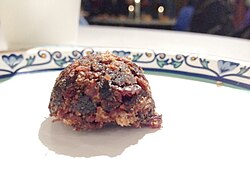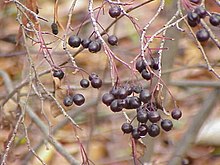Pemmican
 Pemmican ball | |
| Type | Agglomeration |
|---|---|
| Course | Main course |
| Place of origin | North America |
| Region or state | North America |
| Main ingredients | Bison,deer,elkormoose |
Pemmican(alsopemicanin older sources)[1][2]is a mixture oftallow,dried meat,and sometimes dried berries. Acalorie-rich food, it can be used as a key component in prepared meals or eaten raw. Historically, it was an important part ofindigenous cuisinein certain parts ofNorth Americaand it is still prepared today.[3][4]
The name comes from theCreewordᐱᒦᐦᑳᓐ(pimîhkân), which is derived from the wordᐱᒥᕀ(pimî), 'fat, grease'.[5]TheLakota(or Sioux) word iswasná,originally meaning 'grease derived from marrow bones', with thewa-creating a noun, andsnáreferring to small pieces that adhere to something.[6][7]It was invented by theIndigenous peoples of North America.[8][9]
Pemmican was widely adopted as a high-energy food by Europeans involved in thefur tradeand later byArcticandAntarcticexplorers, such asCaptain Robert Bartlett,Ernest Shackleton,Richard E. Byrd,Fridtjof Nansen,Robert Falcon Scott,George W. DeLong,Robert Peary,Matthew Henson,andRoald Amundsen.
Ingredients
[edit]
Pemmican has traditionally been made using whatever meat was available at the time: largegamemeat such asbison,deer,elk,ormoose,but alsofishsuch assalmon,and smaller game such asduck;[10][11]while contemporary pemmican may also includebeef.The meat is dried and chopped, before being mixed with renderedanimal fat(tallow). Dried fruit may be added:cranberries,saskatoon berries(Creemisâskwatômina), and evenblueberries,cherries,chokeberries,andcurrants—though in some regions these are used almost exclusively for ceremonial and wedding pemmican[12]—and European fur traders have also noted the addition of sugar.[10]
Among the Lakota and Dakota nations, there is also a cornwasná(or pemmican) that does not contain dried meat. This is made from toastedcornmeal,animal fat, fruit, andsugar.[13]
Traditional preparation
[edit]
Traditionally, the meat was cut in thin slices and dried, either over a slow fire or in the hot sun until it was hard andbrittle.Approximately 5 pounds (2,300 g) of meat are required to make 1 pound (450 g) of dried meat suitable for pemmican. This thin brittle meat is known in Cree aspânsâwânand colloquially in North American English asdry meat.[14]Thepânsâwânwas then spread across a tanned animal hide pinned to the ground, where it was beaten with flails or ground between two large stones till it turned into very small pieces, almost powder-like in its consistency.[10]The pounded meat was mixed with melted fat in an approximate 1:1 ratio by weight.[15]Typically, the melted fat would besuetthat has beenrenderedintotallow.[16]In some cases, dried fruits, such as blueberries,chokecherries,cranberries, or saskatoon berries, were pounded into powder and then added to the meat-fat mixture. The resulting mixture was then packed intorawhidebags for storage where it would cool, and then harden into pemmican.[10]
Today, some people store their pemmican in glass jars or tin boxes. The shelf life may vary depending on ingredients and storage conditions. At room temperature, pemmican can generally last from one to five years,[17]but there are anecdotal stories of pemmican stored in cool cellars being safely consumed after a decade or more.
A bag of bison pemmican weighing approximately 90 lb (41 kg) was called ataureau(French for "bull" ) by theMétisofRed River.These bags oftaureaux(lit."bulls" ), when mixed with fat from the udder, were known astaureaux fins,when mixed with bone marrow, astaureaux grand,and when mixed with berries, astaureaux à grains.[18][self-published source?]It generally took the meat of one bison to fill ataureau.[19]
Serving
[edit]In his notes of 1874,North-West Mounted PoliceSergeant MajorSam Steelerecorded three ways of serving pemmican: raw, boiled in a stew called "rubaboo",or fried, known in the West as a" rechaud ":[a]
The pemmican was cooked in two ways in the west; one a stew of pemmican, water, flour and, if they could be secured, wild onions or preserved potatoes. This was called "rubaboo"; the other was called by the plains hunters a "rechaud". It was cooked in a frying pan with onions and potatoes or alone. Some persons ate pemmican raw, but I must say I never had a taste for it that way.[20]
History
[edit]As bone grease is an essential ingredient in pemmican, archaeologists consider evidence of its manufacture a strong indicator of pemmican making. There is widespread archaeological evidence (bone fragments and boiling pits) for bone grease production on theGreat Plainsby AD 1, but it likely developed much earlier. However, calcified bone fragments fromPaleo-Indiantimes do not offer clear evidence, due to lack of boiling pits and other possible usages.[21]
It has also been suggested that pemmican may have come through theBering Strait crossing40–60 centuries ago. The first written account of pemmican is considered to beFrancisco Vázquez de Coronadorecords from 1541, of theQuerechosandTeyas,traversing the region later called theTexas Panhandle,who sun-dried and minced bison meat and then would make a stew of it and bison fat. The first written English usage is attributed toJames Isham,who in 1743 wrote that "pimmegan" was a mixture of finely pounded dried meat, fat and cranberries.[22]
Thevoyageursof theNorth American fur tradehad no time to live off the land during the short season when the lakes and rivers were free of ice. They had to carry all of their food with them if the distance traveled was too great to be resupplied along the way.[23]A northcanoe(canot du nord) with six men and 25 standard 90-pound (41 kg) packs required about four packs of food per 500 miles (800 km). Montreal-based canoemen could be supplied by sea or with locally grown food. Their main food was driedpeasorbeans,sea biscuit,andsalt pork.(Western canoemen called their Montreal-based fellowsmangeurs de lardor "pork-eaters".) In theGreat Lakes,somemaizeandwild ricecould be obtained locally. By the time trade reached the Lake Winnipeg area, the pemmican trade was developed.[23]

Trading people of mixed ancestry and becoming known as theMétiswould go southwest onto the prairie inRed River carts,slaughter bison, convert it into pemmican, and carry it north to trade from settlements they would make adjacent toNorth West Companyposts.[24]For these people on the edge of the prairie, the pemmican trade was as important a source of trade goods as was the beaver trade for the Indigenous peoples farther north. This trade was a major factor in the emergence of the new and distinct Métis society. Packs of pemmican would be shipped north and stored at the major fur posts:Fort Alexander,Cumberland House,Île-à-la-Crosse,Fort Garry,Norway House,andEdmonton House.
So important was pemmican that, in 1814, governorMiles Macdonellstarted thePemmican Warwith the Métis when he passed the short-livedPemmican Proclamation,which forbade the export of pemmican from theRed River Colony.[25]
Alexander Mackenzierelied on pemmican on his 1793 expedition fromthe Canadasto the Pacific.[26]
North Pole explorerRobert Pearyused pemmican on all three of his expeditions, from 1886 to 1909, for both his men and his dogs. In his 1917 book,Secrets of Polar Travel,he devoted several pages to the food, stating, "Too much cannot be said of the importance of pemmican to a polar expedition. It is an absolutesine qua non.Without it a sledge-party cannot compact its supplies within a limit of weight to make a serious polar journey successful. "[27]
British polar expeditions fed a type of pemmican to their dogs as "sledging rations". Called "Bovrilpemmican "or simply" dog pemmican ", it was a beef product consisting, by volume, of2⁄3protein and1⁄3fat (i.e., a 2:1 ratio of protein to fat), without carbohydrate. It was later ascertained that although the dogs survived on it, this was not a nutritious and healthy diet for them, being too high in protein.[28]Members ofErnest Shackleton's 1914–1916 expedition to the Antarctic resorted to eating dog pemmican when they were stranded on ice during the antarctic summer.[29]

During theSecond Boer War(1899–1902), British troops were given aniron rationmade of 4 ounces (110 g) of pemmican and 4 ounces of chocolate and sugar. The pemmican would keep in perfect condition for decades.[30]It was considered much superior tobiltong,a form of cured game meats commonly used in Africa. This iron ration was prepared in two small tins (soldered together) that were fastened inside the belts of the soldiers. It was the last ration used and it was used only as a last resort—when ordered by the commanding officer. A man could march on this for 36 hours before he began to drop from hunger.[31]
While serving as chief of scouts for the British Army in South Africa, American adventurerFrederick Russell Burnhamrequired pemmican to be carried by every scout.[32]
Pemmican, likely condensed meat bars, was used as a ration for French troops fighting in Morocco in the 1920s.[33]
A 1945 scientific study of pemmican criticized using it exclusively as a survival food because of the low levels of certain vitamins.[34]
A study was later done by the U.S. military in January 1969, entitledArctic Survival Rations, III. The Evaluation of Pemmican Under Winter Field Conditions.[35]The study found that during a cycle of two starvation periods the subjects could stave off starvation for the first cycle of testing with only 1000 calories worth of pemmican.[35]
Contemporary uses
[edit]Today, people in many indigenous communities across North America continue to make pemmican for personal, community, and ceremonial consumption. Some contemporary pemmican recipes incorporate ingredients that have been introduced to the Americas in the past 500 years, including beef. There are also indigenous-owned companies, such as Tanka Bar, based onPine Ridge Indian Reservationin South Dakota, that produce pemmican or foods based on traditional pemmican recipes, for commercial distribution.
See also
[edit]- Kanemochi,also called "buttermochi"(バター bính), a similar high caloric density food invented by Japanesematagihunters
- Alaskan ice cream
- Food drying
- Forcemeat
- Jerky
- Mincemeat
- Nutraloaf
- Pastirma
- Smoked fish
- Smoked meat
- Tolkusha
- Viande fumée
Notes
[edit]- ^also spelledricheau, rasho, richot, rouchou, rousseau, rusho(o), rowshow,etc. see,http://dchp.ca/DCHP-1/entries/view/richeau
References
[edit]- ^Ballantyne, Robert Michael (1876).Away in the Wilderness.Philadelphia: Porter & Coates. pp. 81–84.
- ^Anderson, Anne (1973).The Great Outdoors Kitchen: Native Cookbook.Cree Productions.ISBN9780919864290.
- ^"Wo Lakota Making Wasna".Lakota Red Nations. 2017-11-30.Retrieved2018-09-17.
- ^"NANF".www.tankabar.com.
- ^Sinclair, J.M. (ed)English DictionaryHarper Collins: 2001.
- ^"Native Recipes".sacred.indigenous.youth.education.circle.mysite.com.
- ^"New Lakota Dictionary Online".www.lakotadictionary.org.Retrieved2020-02-12.
- ^McLagan, Jennifer (2008).Fat: An Appreciation of a Misunderstood Ingredient.Ten Speed Press. p. 195.ISBN978-1580089357.
- ^Morton, Mark (2004).Cupboard Love: A Dictionary of Culinary Curiosities.Insomniac Press. p.222.ISBN1894663667.
- ^abcdMerriam, Willis B. (1955). "The Role of Pemmican in the Canadian Northwest Fur Trade".Yearbook of the Association of Pacific Coast Geographers.17(1): 34–38.doi:10.1353/pcg.1955.0000.ISSN1551-3211.S2CID130451803.
- ^Sherman, Sean (2017).The Sioux Chef's Indigenous Kitchen.Minneapolis, Minnesota: University of Minnesota Press.ISBN978-0816699797.
- ^Albala, Kevn (2011).Food Cultures of the World Encyclopedia.Abc-Clio. p. 235.ISBN9780313376269.
- ^Goodwin, Janice."Healthy Traditions: Recipes of our Ancestors"(PDF).National Center for Native American Aging at the Center for Rural Health, University of North Dakota School of Medicine & Health Sciences.Retrieved2020-02-12.
- ^Gladue, Ian."Interviewed with owner of Pânsâwân Dry Meat".CBC Radio.Radio Active.Retrieved2019-01-29.
- ^Angier, Bradford.How to Stay Alive in the Woods(originally published asLiving off the Country1956)ISBN978-1-57912-221-8Black Dog & Levanthal. p. 107
- ^"Pemmican Recipes".Alderleaf Wilderness College.Retrieved2019-02-23.
- ^"How Long Does Pemmican Last (GUIDE)".Ultimate Prepping.2017-05-27.
- ^Barkwell, Lawrence J."How the Metis make pemmican".Retrieved2013-01-24.
- ^Hargrave, Joseph James (1871).Red River.Montreal: J. Lovell. p. 168.OCLC5035707.
- ^Myrna Kostash; Duane Burton (2005).Reading the River: A Traveller's Companion to the North Saskatchewan River.Coteau Books. p. 160.ISBN978-1-55050-317-3.
- ^Bamforth, Douglas B. (2011)."Origin Stories, Archaeological Evidence, and Postclovis Paleoindian Bison Hunting on the Great Plains".American Antiquity.76(1): 24–40.doi:10.7183/0002-7316.76.1.24.ISSN0002-7316.S2CID163282801.
- ^Ngapo, Tania M.; Champagne, Claude; Chilian, Cornelia; Dugan, Michael E.R.; Gariépy, Stéphane; Vahmani, Payam; Bilodeau, Pauline (August 2021)."Pemmican, an endurance food: Past and present".Meat Science.178:108526.doi:10.1016/j.meatsci.2021.108526.PMID33945979.S2CID233744039.
- ^abCarolyn Podruchny (2006).Making the Voyageur World: Travelers and Traders in the North American Fur Trade.U of Nebraska Press. p. 118.ISBN0-8032-8790-9.
- ^ O'Brien, Sam,"How to Make a 5,000-Year-Old Energy Bar",Atlas Obscura,April 30, 2020
- ^Hayes, Derek (2006).Historical Atlas of Canada.Douglas & McIntyre. p. 178.ISBN9781553650775.
- ^Stefansson, Vilhjalmur (2005).Great Adventures and Explorations: From the Earliest Times to the Present As Told by the Explorers Themselves.Kessinger. p. 328.ISBN1417990902.[permanent dead link]
- ^Peary, Robert E. (1917).Secrets of Polar Travel.Century Company. pp.77–83.
- ^Taylor, R. J. F. (January 1957)."The physiology of sledge dogs".Polar Record.8(55): 317–321.Bibcode:1957PoRec...8..317T.doi:10.1017/S003224740004924X.S2CID129952806.
- ^Alfred Lansing (1969),Endurance,New York: McGraw Hill, Library of Congress Catalog Card Number: 58-59666
- ^Stefansson, Vilhjalmur (1946).Not by Bread Alone.New York: MacMillan Company. pp.211,270.OCLC989807.
- ^Stefansson, Vilhjalmur (1946).Not by Bread Alone.New York: MacMillan Company. pp.263–264, 270.OCLC989807.
- ^Burnham, Frederick Russell (1926).Scouting on Two Continents.New York: Doubleday, Page & Company.OCLC407686.
- ^Rupert Furneaux, Abdel Krim, p.177
- ^"Defects of Pemmican as an Emergency Ration for Infantry Troops".Nutrition Reviews.3(10): 314–315. 1 October 1945.doi:10.1111/j.1753-4887.1945.tb08500.x.
- ^ab"Pemmican".Nutrition Reviews.19(3): 73–75. 2009-04-27.doi:10.1111/j.1753-4887.1961.tb01895.x.S2CID252701647.
